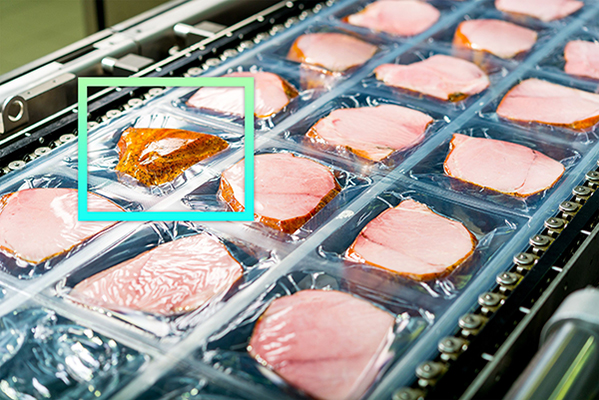AI-powered software can be used to quickly set up additional digital eyes on the production floor to leverage existing IIoT infrastructure.
In March 2020, when the US began its long and painful dive into a lockdown society, consumers rushed to grocery stores with the goal of acting swiftly to secure items they might need for the long road ahead. To the surprise of many, or at least the writer of this story, the lack of toilet paper appeared to be a nightmare scenario. Scared Americans raced to the shelves, hoarding hundreds of yards of this (seemingly) life-saving item.
Fast-forward to October 2021: consumers have re-aligned priorities, and with that, the types of items missing from shelves has changed. Supply chain issues, workforce disruption, COVID-19 restrictions, the rising cost of shipping and congestion at ports, have all conspired to cause severe shortages in grocery stores. And, this time, unfortunately, some missing items are truly indispensable.
I am talking about food.
From popular meal kit and canned goods (soups, vegetables), to meat and fish, all the way down to our favorite wine and liquors, grocery stores have seen on-shelf-availability rate drop from 95.2% in August to 94.6% in September. In plain terms, stores can’t re-stock their items fast enough to catch up with their disappearance from shelves.
This issue has not gone unnoticed. In February 2021, the current Administration issued an executive order to help find fixes to the main supply chains issues facing US today – and get the food we need back in US stores. That said, many of the solutions require additional “hands on deck.” Wiith job openings at a record high and fewer and fewer people willing to spend time in factories, those hands likely won’t be the ones of human workers.
Rather, they will be “digital hands” made up of technologies such as artificial intelligence (AI), automation, industrial IoT and robotics – innovations that are being implemented to produce more in the face of increased productivity pressures and reduced workforce.

When it comes to quickly improving the food supply chain to ensure these indispensable items make it to the grocery story, it all starts with manufacturing. One area where AI can have a profound impact is visual quality inspection. Deploying AI to improve quality inspection has the potential to protect us from contaminants by finding defects early, avoiding costly waste and brand-damaging recalls.
Today, AI-powered software can be used to quickly set up additional “digital eyes” – visual quality inspection models that emulate aspects of human vision processing – that can be easily integrated on the production floor leveraging existing IIoT infrastructure. This means that product quality can be improved in the face of absent workers, and, more importantly, without breaking the bank by using inexpensive cameras and industrial computers that are readily available. This ensures a quick path to ROI for enterprises embracing AI, with financial results that are tangible in the span of weeks vs. years.
What would be the benefit of such an innovation? In 2020 alone, the U.S. Food & Drug Administration (FDA) has recalled 7.2K products, a costly process for manufacturers. It is estimated that the average cost of a product recall for a food company is $10M, a hefty price to pay for a preventable issue. In fact, it is estimated that manufacturers’ cost of a defect can balloon 10-thousand-fold from when the defect is caught in production – by a thorough visual inspection process – vs. causing a recall once the product hits the shelves.
As mentioned, this is a problem that can’t be solved by simply adding human workers. Research predicts that by 2030 there will be 47K fewer human workers performing quality inspection in the US – a significant deficit that will add to the existing pressures manufacturers already face.
Necessity spurs innovation, and the AI-powered food manufacturer will not be a “nice to have,” but a key feature for companies looking to limit waste and its associated costs. Innovation in the food manufacturing workflow that can be applied as early as the inspection of raw food ingredients will be a game changer for the industry. AI today can be set up in minutes to inspect ingredients for contaminants – sometimes not even possible for factory personnel (e.g. too fast of a process to be subject to human oversight). Down the production line, AI-powered inspection models can be deployed to ensure food trays in ready-made meals are all present. And, once products are ready for shipping, AI can double-check that a food can case is correctly wrapped, with the right product in the right box by comparing barcodes of products and packaging. Only when this “AI pre-screening” is complete and a problem arises, do precious human workers need to be engaged for fixing an existing problem, making their job more efficient and less repetitive/mechanical.
Today, food manufacturers are surely facing unprecedented issues – but we are fortunate enough to live in a world where powerful technology can come to the rescue. Artificial intelligence is one of such ready-to-deploy technologies already helping manufacturers solve the toughest production challenges. Food manufacturers that are taking action now will most likely be leading the pack as we enter a new era of AI-augmented food manufacturing.

Massimiliano Versace is the co-founder and CEO of Neurala Inc., a Boston-based company building Artificial Intelligence emulating brain function in software. He co-founded the Boston University Neuromorphics Lab, authored dozens among academic papers, book chapters, and patents, and lectured at dozens of events and venues, from TedX to DARPA, NASA, Pentagon, GTC, Los Alamos National Labs, Air Force Research Labs and dozens of companies. With specialties in artificial intelligence, neural networks, deep learning, reinforcement learning, edge intelligence, neuromorphic engineering, cognitive modeling, spiking neurons, robotics.
Scott Ellyson, CEO of East West Manufacturing, brings decades of global manufacturing and supply chain leadership to the conversation. In this episode, he shares practical insights on scaling operations, navigating complexity, and building resilient manufacturing networks in an increasingly connected world.